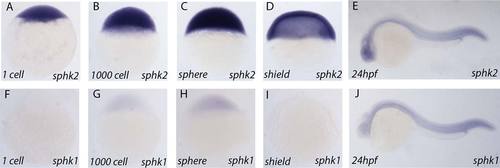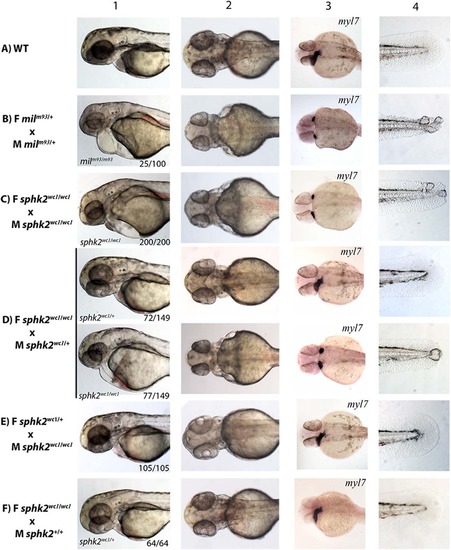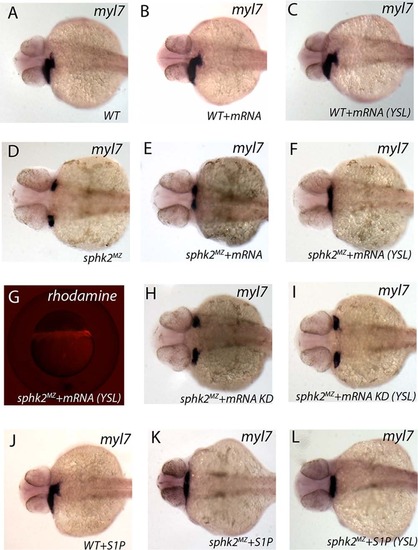- Title
-
Maternal or zygotic sphingosine kinase is required to regulate zebrafish cardiogenesis
- Authors
- Mendelson, K., Lan, Y., Hla, T., Evans, T.
- Source
- Full text @ Dev. Dyn.
|
The sphk2 gene is maternally expressed. Shown are representative wildtype embryos analyzed for sphk2 transcripts by in situ hybridization at the stages indicated: (A) one-cell stage, (B) 1,000-cell stage (3 hpf), (C) sphere stage (blastula, 4 hpf), and (D) shield stage (gastrulation, 6 hpf). (E) At 24 hpf, sphk2 is expressed ubiquitously. In contrast (F–J), sphk1 transcripts are not detected above background by in situ hybridization until somitogenesis. |
|
The sphk2MZ mutant phenocopies the mil zygotic mutant. Shown are representative embryos at 32 hr post fertilization imaged in brightfield (column 1: lateral view, anterior to the left), (column 2: ventral view, anterior to the left), or analyzed by in situ hybridization for expression of the myl7 gene (column 3, ventral view, anterior to the left). Column 4 shows representative images of tails at this stage. Embryos were derived from crosses as indicated on the left: (A) Wildtype (WT), (B) heterozygous mil adults, (C) female and male sphk2wc1/wc1 mutants, (D) female sphk2 homozygous mutant and male sphk2 heterozygous mutant and (E) female sphk2 heterozygous mutant and male sphk2 homozygous mutant. (F) Female sphk2 homozygous mutant crossed to a wildtype male. Note that only the homozygous mil mutant embryos (25% of the embryos from the heterozygote parental cross) display pericardial edema (columns 1, 2), cardia bifida (column 3), and tail blisters (column 4), as do 100% (200/200) of the sphk2MZ mutant embryos. These phenotypes are rescued in embryos that have a single wildtype allele (72/149, 48% of the embryos in D), if embryos inherit maternal message from a wildtype maternal allele (50% of the embryos in E, which are zygotically null but phenotypically normal), or if embryos inherit a single wildtype allele from the male parent (64/64, 100% of the embryos in F). |
|
Expression of Sphk2 in YSL can rescue normal cardiogenesis. Shown are representative embryos following in situ hybridization for myl7 transcripts at 32 hpf. (A) Wildtype (WT) embryos (25/25, 100%) display normal cardiac development. (B) Injection of 250 pg of sphk2 mRNA into the single cell (65/65, 100%) or (C) targeted to the YSL (51/51, 100%) does not alter cardiac development. (D) All maternal/zygotic sphk2MZ embryos show the cardia bifid phenotype (0/40 embryos are normal, 0%). (E) Injection of 250 pg sphk2 mRNA into the 1-cell stage embryos was able to rescue the bifid phenotype as shown by the presence of cardiac tissue at the midline (7/44 embryos, 16%). (F) Targeting 250 pg sphk2 mRNA specifically into the YSL (confirmed by co-injection of rhodamine dextran tracer, as documented in G) was able to rescue the bifid phenotype (19/88 embryos, 22%). (H) In contrast, injection of mRNA encoding a predicted kinase dead Sphk2 (KD) into the fertilized egg (56/56, 100%) or (I) targeted to the YSL (43/43, 100%) failed to rescue the bifid phenotype. (J) Injection of 1 ng S1P in the fertilized egg (47/47, 100%) or YSL (47/47, 100%, not shown) did not alter cardiac development of wildtype embryos, whereas (K) injection of 1 ng S1P into the fertilized egg (15/51, 29%) or (L) targeted to the YSL (9/32, 28%) was able to rescue the bifid phenotype of sphk2MZ embryos. |



